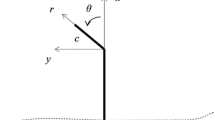Abstract
The tensile creep fracture behaviors in brittle solids are of great significance for the safety evaluation of brittle solid engineering. However, micromechanics-based tensile creep fracture behavior is rarely studied. In this study, a micromechanics-based method for predicting direct tensile creep fractures is presented. This method is established by combining the suggested expression of the mode-I stress intensity factor, the subcritical crack growth law, and the relationship between wing crack length and axial strain. This suggested mode-I stress intensity factor is formulated by the use of the basic theory of fracture mechanics under different loading modes. The rationality of the proposed tensile creep fracture model is verified by comparing with the experimental results. The correspondences of time-dependent axial strain, strain rate, wing crack length, and crack velocity are plotted under constant stress and stepping stress during tensile creep fracture. The effects of the initial crack size, inclination angle and density on the crack initiation stress, tensile strength, tensile creep fracture time, steady-state strain rate, initial strain, crack coalescence strain, and failure strain are discussed.







Similar content being viewed by others
References
Okubo S, Fukui K. Complete stress-strain curves for various rock types in uniaxial tension. Int J Rock Mech Mini Sci Geomech Abstr. 1996;33(6):549–56.
Hawkes I, Mellor M, Gariepy S. Deformation of rocks under uniaxial tension. Int J Rock Mech Min Sci Geomech Abstr. 1973;10(6):493–507.
Li HB, Li JC, Liu B, et al. Direct tension test for rock material under different strain rates at quasi-static loads. Rock Mech Rock Eng. 2013;46:1247–54.
Nova R, Zaninetti A. An investigation into the tensile behaviour of a schistose rock. Int J Rock Mech Min Sci Geomech Abstr. 1990;27(4):231–42.
Zhang B, Yang XY. LI SC, Guo S, Tang PY, Li HY, Yang L, Sun HF, Wang SG, Uniaxial tensile failure properties of rock-like specimens with two overlapped X -type flaws. J China Coal Soc. 2017;42(08):1988–94.
Huang ZH, Deng SC, LI HB, , et al. Experimental study and numerical simulation of crack propagation process and intersection mode under tensile load. Chin J Rock Mech Eng. 2019;38(11):2712–23.
Saadat M, Taheri A. Modelling micro-cracking behaviour of granite during direct tensile test using cohesive GBM approach. Eng Fract Mech. 2020;239: 107297.
Brantut N, Baud P, Heap MJ, Meredith PG. Micromechanics of brittle creep in rocks. J Geophys Res. 2012;117:B08412.
Li XZ, Qu XL, Qi CZ, et al. A unified analytical method calculating brittle rocks deformation induced by crack growth. Int J Rock Mech Min Sci. 2019;113:134–41.
Li XZ, Shao ZS, Qi CZ. An analytical micro-macro model of stress drops during brittle creep in rocks. Eng Fract Mech. 2020;223: 106794.
Wang JB, Zhang Q, Song ZP, et al. Creep properties and damage constitutive model of salt rock under uniaxial compression. Int J Damage Mech. 2020;29(6):902–22.
Yu J, Liu GY, Cai YY, et al. Time-dependent deformation mechanism for swelling soft-rock tunnels in coal mines and its mathematical deduction. Int J Geomech. 2020;20(3):04019186.
Carroll DF, Wiederhorn SM, Roberts DE. Technique for tensile creep testing of ceramics. J Am Ceram Soc. 1989;72(9):1610–4.
Zhao BY, Liu DY, Dong Q. Experimental research on creep behaviors of sandstone under uniaxial compressive and tensile stresses. J Rock Mech Geotech Eng. 2011;3(S1):438–44.
Zhang Y, Zhang QY, Zhou XY, et al. Direct tensile tests of red sandstone under different loading rates with the self-developed centering device. Geotech Geol Eng. 2021;39:709–18.
Peng RD, Ju Y, Xie HP. Fractal characterization of meso-structural evolution during tension of limestone. Rock Soil Mech. 2007;28(12):2579–88.
Ban YX, Fu X, Xie Q, et al. Time-sensitivity mechanism of rock stress memory properties under tensile stress. J Rock Mech Geotech Eng. 2020;12(3):528–40.
Kaiser J. A study of acoustic phenomena in tensile tests. FRG: Technische Hochschule Munched; 1950.
Gerd M. Application of the cluster analysis and time statistic of acoustic emission events from tensile test of a cylindrical rock salt specimen. Eng Fract Mech. 2019;210:84–94.
Charles RJ. Static fatigue of glass i. J Appl Phys. 1958;29(11):1549–53.
Atkinson BK. Subcritical crack growth in geological materials. J Geophys Res. 1984;89(B6):4077–114.
Kim JY, Lee SB. A tensile crack in creeping solids with large damage near the crack tip. Int J Fract. 2001;112:43–55.
Ashby MF, Sammis CG. The damage mechanics of brittle solids in compression. Pure Appl Geophys. 1990;133(3):489–521.
Li XZ, Qi CZ, Shao ZS, et al. Evaluation of strength and failure of brittle rock containing initial cracks under lithospheric conditions. Acta Geophys. 2018;66(2):141–52.
Tada H, Paris PC, Irwin GR. The stress analysis of cracks handbook. St. Louis, Mo: Del Res; 1985.
Budiansky B, O’Connel RJ. Elastic moduli of a cracked solid. Int J Solids Struct. 1976;12:81–97.
Acknowledgements
This work was supported by the National Natural Science Foundation of China (Grant No. 51708016); the Scientific Research Program of Beijing Municipal Education Commission (KM202110016014); and the Pyramid Talent Training Project of Beijing University of Civil Engineering and Architecture (Grant No. JDYC20200307).
Author information
Authors and Affiliations
Corresponding author
Rights and permissions
About this article
Cite this article
Li, X., Qi, C. An Analytical Method for Predicting Direct Tensile Creep Fracture in Brittle Solids Containing Initial Microcracks. Acta Mech. Solida Sin. 35, 152–160 (2022). https://doi.org/10.1007/s10338-021-00254-8
Received:
Revised:
Accepted:
Published:
Issue Date:
DOI: https://doi.org/10.1007/s10338-021-00254-8




